Financial Plan, Budget, and Risk Management for Ed's Whitegoods
VerifiedAdded on 2022/12/22
|11
|2389
|31
Report
AI Summary
This report details the formulation and implementation of a financial plan for Ed’s Whitegoods, encompassing profitability and performance measurement. It includes budget planning, profitability analysis, and discussions with management and the finance manager to assess the feasibility of the plan. The report covers sales forecasting, projected financial statements (income statement, cash flow statement, and balance sheet), and a risk management process. It analyzes financial performance based on previous data and assumptions, addressing the impact of cost changes and pricing strategies on profitability. The report also outlines a risk management process involving a monitoring team to assess sales and market effectiveness, with personnel performance and sales targets tracked regularly, along with inventory management to reduce costs. The conclusion summarizes the process of developing the business and financial plan and its presentation to the finance manager.
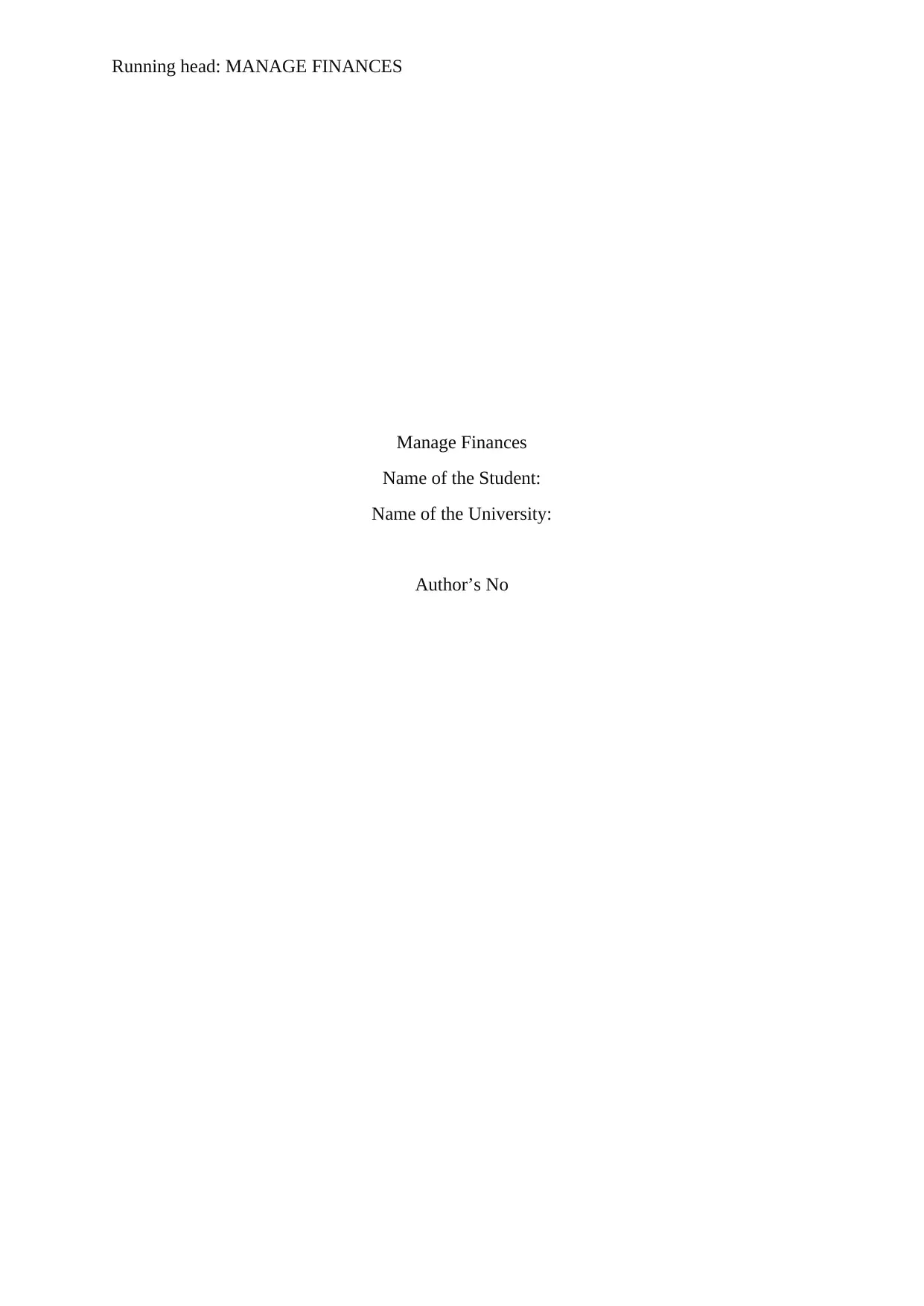
Running head: MANAGE FINANCES
Manage Finances
Name of the Student:
Name of the University:
Author’s No
Manage Finances
Name of the Student:
Name of the University:
Author’s No
Paraphrase This Document
Need a fresh take? Get an instant paraphrase of this document with our AI Paraphraser
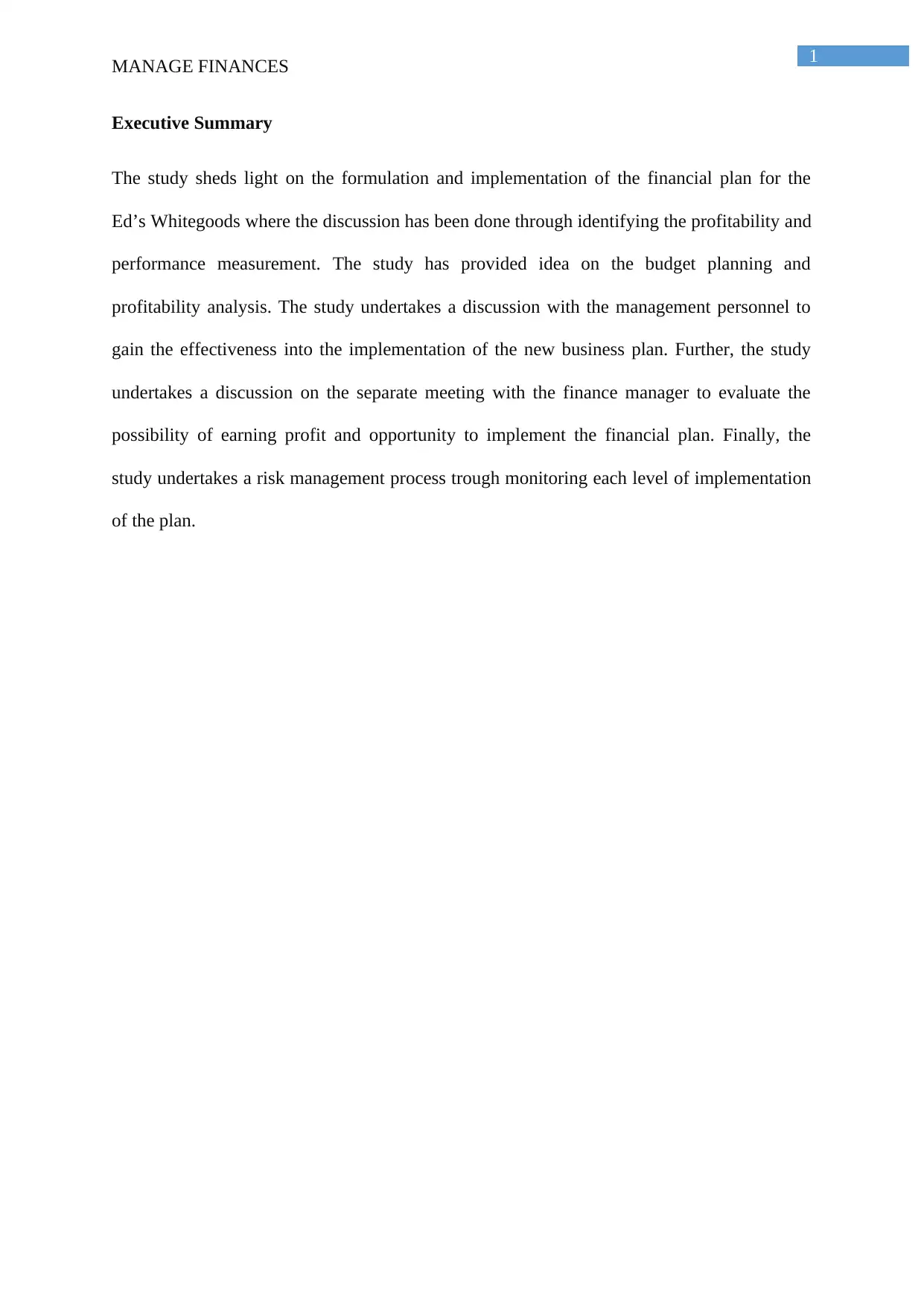
1
MANAGE FINANCES
Executive Summary
The study sheds light on the formulation and implementation of the financial plan for the
Ed’s Whitegoods where the discussion has been done through identifying the profitability and
performance measurement. The study has provided idea on the budget planning and
profitability analysis. The study undertakes a discussion with the management personnel to
gain the effectiveness into the implementation of the new business plan. Further, the study
undertakes a discussion on the separate meeting with the finance manager to evaluate the
possibility of earning profit and opportunity to implement the financial plan. Finally, the
study undertakes a risk management process trough monitoring each level of implementation
of the plan.
MANAGE FINANCES
Executive Summary
The study sheds light on the formulation and implementation of the financial plan for the
Ed’s Whitegoods where the discussion has been done through identifying the profitability and
performance measurement. The study has provided idea on the budget planning and
profitability analysis. The study undertakes a discussion with the management personnel to
gain the effectiveness into the implementation of the new business plan. Further, the study
undertakes a discussion on the separate meeting with the finance manager to evaluate the
possibility of earning profit and opportunity to implement the financial plan. Finally, the
study undertakes a risk management process trough monitoring each level of implementation
of the plan.
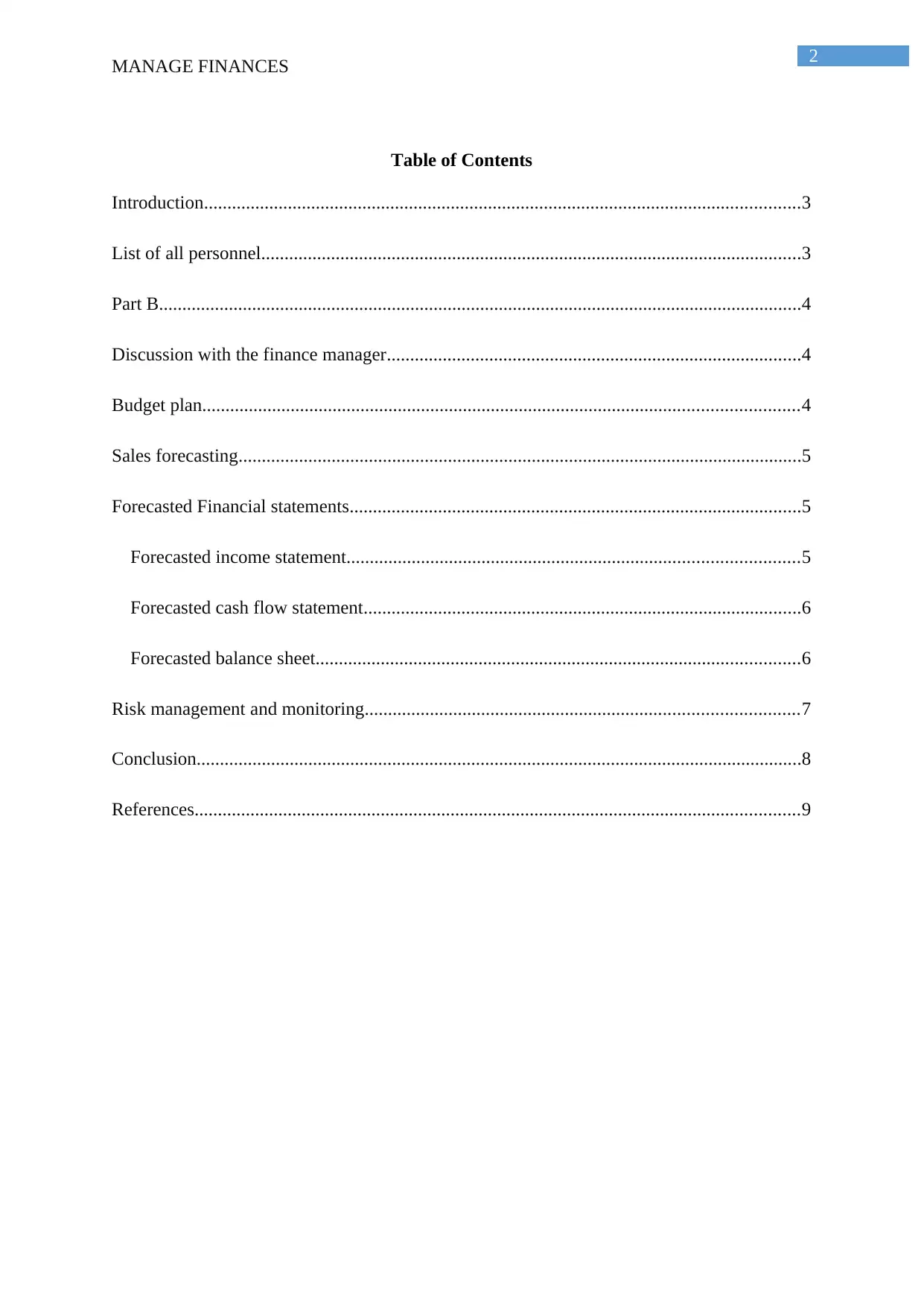
2
MANAGE FINANCES
Table of Contents
Introduction................................................................................................................................3
List of all personnel....................................................................................................................3
Part B..........................................................................................................................................4
Discussion with the finance manager.........................................................................................4
Budget plan................................................................................................................................4
Sales forecasting.........................................................................................................................5
Forecasted Financial statements.................................................................................................5
Forecasted income statement.................................................................................................5
Forecasted cash flow statement..............................................................................................6
Forecasted balance sheet........................................................................................................6
Risk management and monitoring.............................................................................................7
Conclusion..................................................................................................................................8
References..................................................................................................................................9
MANAGE FINANCES
Table of Contents
Introduction................................................................................................................................3
List of all personnel....................................................................................................................3
Part B..........................................................................................................................................4
Discussion with the finance manager.........................................................................................4
Budget plan................................................................................................................................4
Sales forecasting.........................................................................................................................5
Forecasted Financial statements.................................................................................................5
Forecasted income statement.................................................................................................5
Forecasted cash flow statement..............................................................................................6
Forecasted balance sheet........................................................................................................6
Risk management and monitoring.............................................................................................7
Conclusion..................................................................................................................................8
References..................................................................................................................................9
⊘ This is a preview!⊘
Do you want full access?
Subscribe today to unlock all pages.

Trusted by 1+ million students worldwide
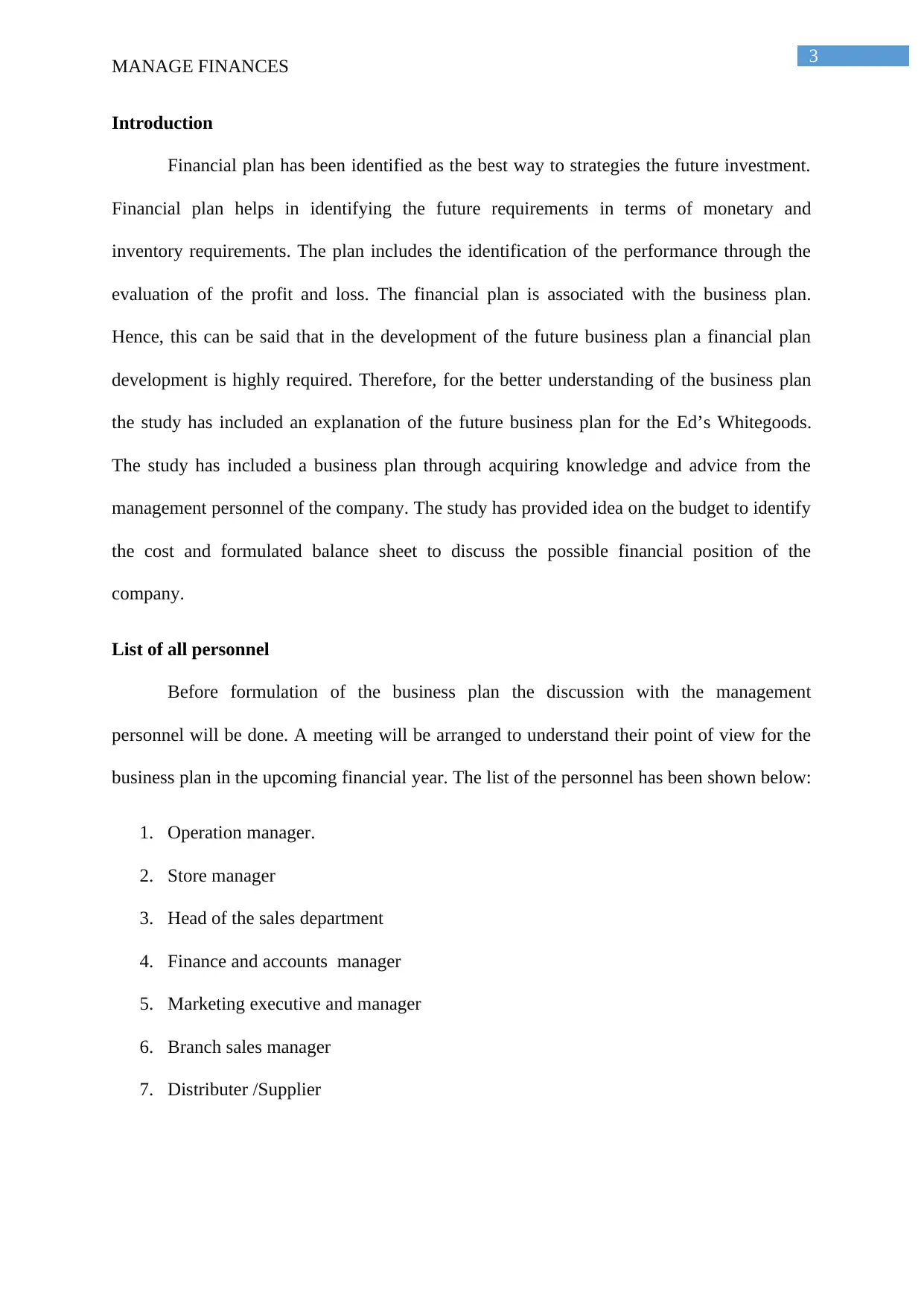
3
MANAGE FINANCES
Introduction
Financial plan has been identified as the best way to strategies the future investment.
Financial plan helps in identifying the future requirements in terms of monetary and
inventory requirements. The plan includes the identification of the performance through the
evaluation of the profit and loss. The financial plan is associated with the business plan.
Hence, this can be said that in the development of the future business plan a financial plan
development is highly required. Therefore, for the better understanding of the business plan
the study has included an explanation of the future business plan for the Ed’s Whitegoods.
The study has included a business plan through acquiring knowledge and advice from the
management personnel of the company. The study has provided idea on the budget to identify
the cost and formulated balance sheet to discuss the possible financial position of the
company.
List of all personnel
Before formulation of the business plan the discussion with the management
personnel will be done. A meeting will be arranged to understand their point of view for the
business plan in the upcoming financial year. The list of the personnel has been shown below:
1. Operation manager.
2. Store manager
3. Head of the sales department
4. Finance and accounts manager
5. Marketing executive and manager
6. Branch sales manager
7. Distributer /Supplier
MANAGE FINANCES
Introduction
Financial plan has been identified as the best way to strategies the future investment.
Financial plan helps in identifying the future requirements in terms of monetary and
inventory requirements. The plan includes the identification of the performance through the
evaluation of the profit and loss. The financial plan is associated with the business plan.
Hence, this can be said that in the development of the future business plan a financial plan
development is highly required. Therefore, for the better understanding of the business plan
the study has included an explanation of the future business plan for the Ed’s Whitegoods.
The study has included a business plan through acquiring knowledge and advice from the
management personnel of the company. The study has provided idea on the budget to identify
the cost and formulated balance sheet to discuss the possible financial position of the
company.
List of all personnel
Before formulation of the business plan the discussion with the management
personnel will be done. A meeting will be arranged to understand their point of view for the
business plan in the upcoming financial year. The list of the personnel has been shown below:
1. Operation manager.
2. Store manager
3. Head of the sales department
4. Finance and accounts manager
5. Marketing executive and manager
6. Branch sales manager
7. Distributer /Supplier
Paraphrase This Document
Need a fresh take? Get an instant paraphrase of this document with our AI Paraphraser
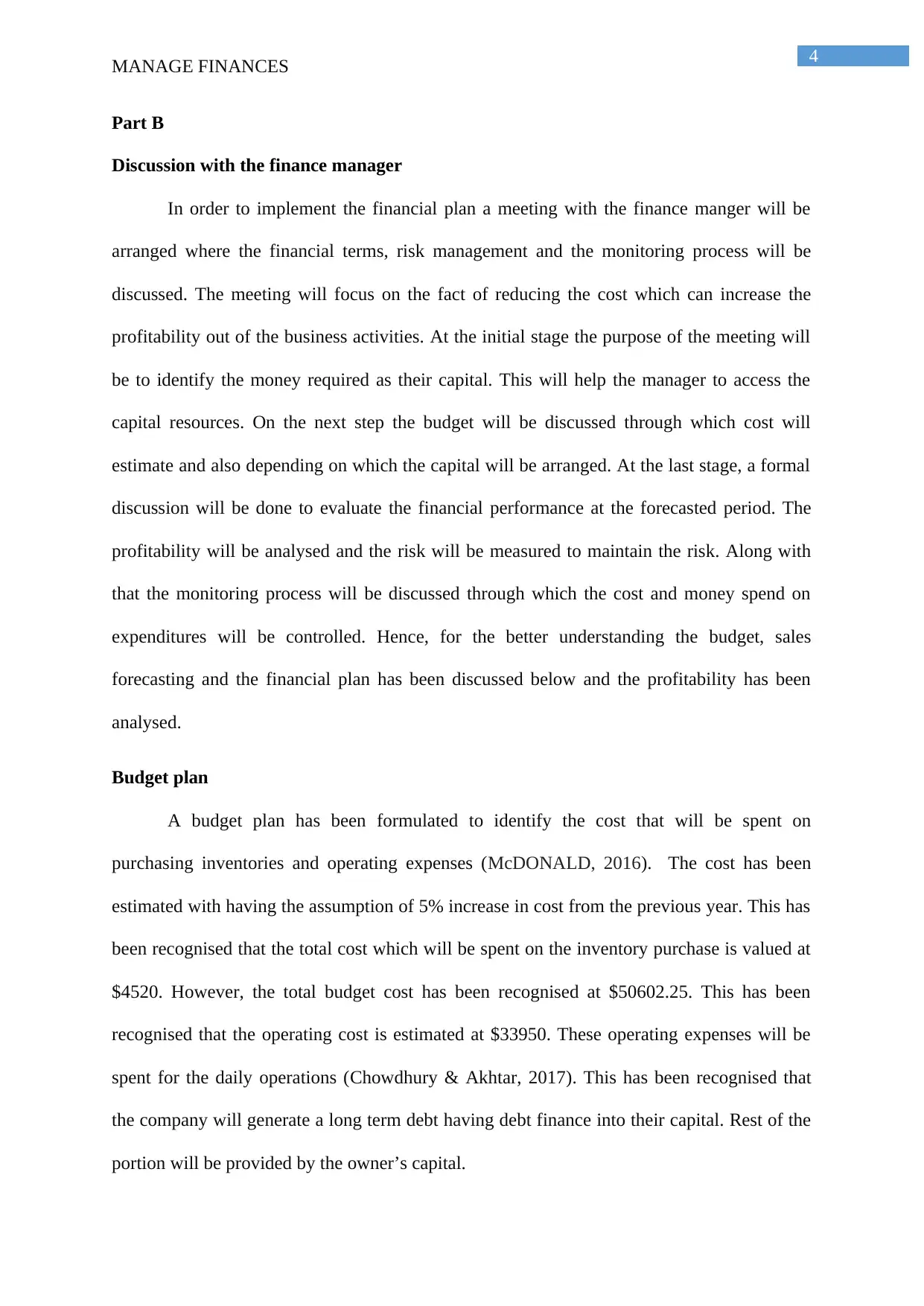
4
MANAGE FINANCES
Part B
Discussion with the finance manager
In order to implement the financial plan a meeting with the finance manger will be
arranged where the financial terms, risk management and the monitoring process will be
discussed. The meeting will focus on the fact of reducing the cost which can increase the
profitability out of the business activities. At the initial stage the purpose of the meeting will
be to identify the money required as their capital. This will help the manager to access the
capital resources. On the next step the budget will be discussed through which cost will
estimate and also depending on which the capital will be arranged. At the last stage, a formal
discussion will be done to evaluate the financial performance at the forecasted period. The
profitability will be analysed and the risk will be measured to maintain the risk. Along with
that the monitoring process will be discussed through which the cost and money spend on
expenditures will be controlled. Hence, for the better understanding the budget, sales
forecasting and the financial plan has been discussed below and the profitability has been
analysed.
Budget plan
A budget plan has been formulated to identify the cost that will be spent on
purchasing inventories and operating expenses (McDONALD, 2016). The cost has been
estimated with having the assumption of 5% increase in cost from the previous year. This has
been recognised that the total cost which will be spent on the inventory purchase is valued at
$4520. However, the total budget cost has been recognised at $50602.25. This has been
recognised that the operating cost is estimated at $33950. These operating expenses will be
spent for the daily operations (Chowdhury & Akhtar, 2017). This has been recognised that
the company will generate a long term debt having debt finance into their capital. Rest of the
portion will be provided by the owner’s capital.
MANAGE FINANCES
Part B
Discussion with the finance manager
In order to implement the financial plan a meeting with the finance manger will be
arranged where the financial terms, risk management and the monitoring process will be
discussed. The meeting will focus on the fact of reducing the cost which can increase the
profitability out of the business activities. At the initial stage the purpose of the meeting will
be to identify the money required as their capital. This will help the manager to access the
capital resources. On the next step the budget will be discussed through which cost will
estimate and also depending on which the capital will be arranged. At the last stage, a formal
discussion will be done to evaluate the financial performance at the forecasted period. The
profitability will be analysed and the risk will be measured to maintain the risk. Along with
that the monitoring process will be discussed through which the cost and money spend on
expenditures will be controlled. Hence, for the better understanding the budget, sales
forecasting and the financial plan has been discussed below and the profitability has been
analysed.
Budget plan
A budget plan has been formulated to identify the cost that will be spent on
purchasing inventories and operating expenses (McDONALD, 2016). The cost has been
estimated with having the assumption of 5% increase in cost from the previous year. This has
been recognised that the total cost which will be spent on the inventory purchase is valued at
$4520. However, the total budget cost has been recognised at $50602.25. This has been
recognised that the operating cost is estimated at $33950. These operating expenses will be
spent for the daily operations (Chowdhury & Akhtar, 2017). This has been recognised that
the company will generate a long term debt having debt finance into their capital. Rest of the
portion will be provided by the owner’s capital.
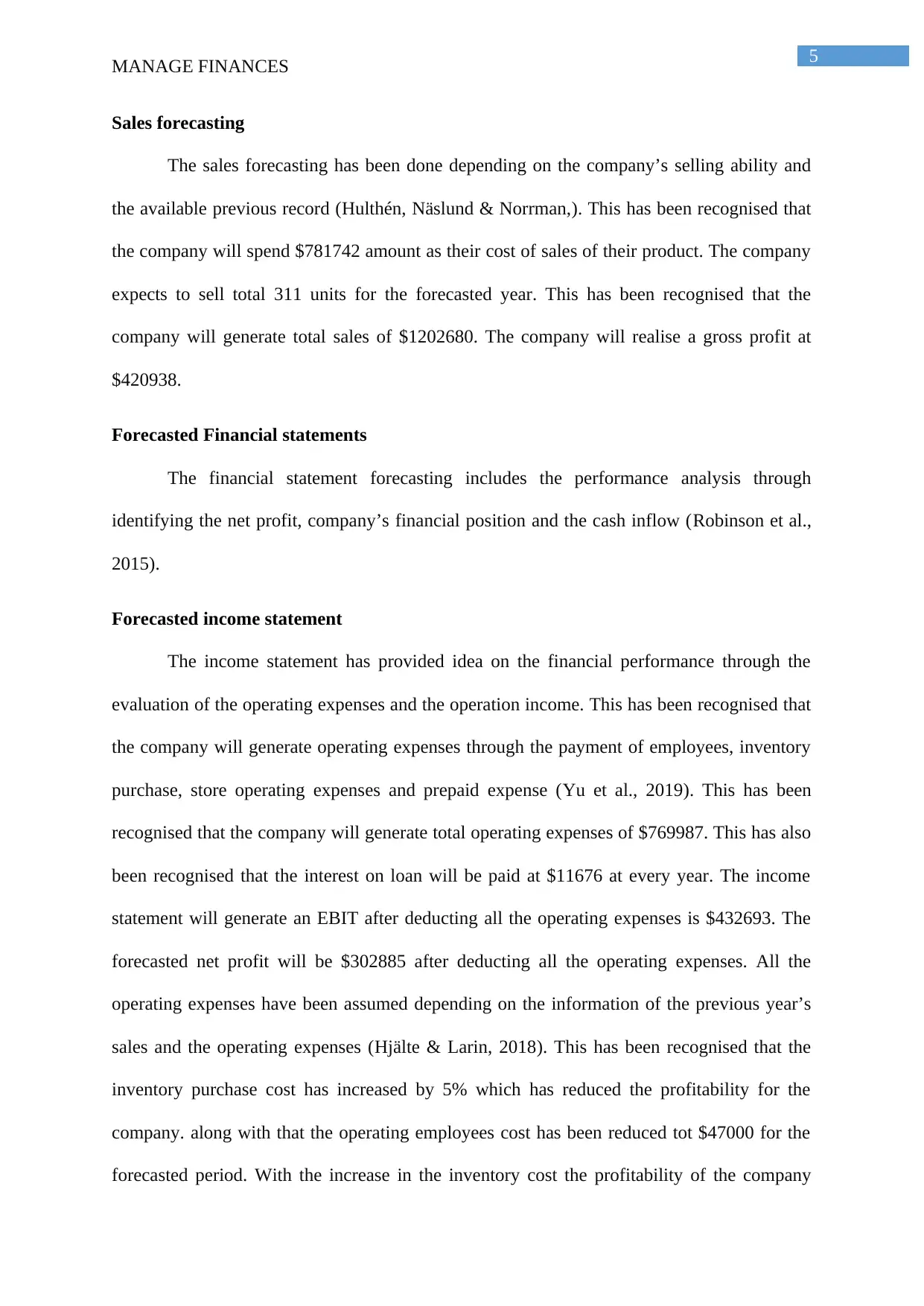
5
MANAGE FINANCES
Sales forecasting
The sales forecasting has been done depending on the company’s selling ability and
the available previous record (Hulthén, Näslund & Norrman,). This has been recognised that
the company will spend $781742 amount as their cost of sales of their product. The company
expects to sell total 311 units for the forecasted year. This has been recognised that the
company will generate total sales of $1202680. The company will realise a gross profit at
$420938.
Forecasted Financial statements
The financial statement forecasting includes the performance analysis through
identifying the net profit, company’s financial position and the cash inflow (Robinson et al.,
2015).
Forecasted income statement
The income statement has provided idea on the financial performance through the
evaluation of the operating expenses and the operation income. This has been recognised that
the company will generate operating expenses through the payment of employees, inventory
purchase, store operating expenses and prepaid expense (Yu et al., 2019). This has been
recognised that the company will generate total operating expenses of $769987. This has also
been recognised that the interest on loan will be paid at $11676 at every year. The income
statement will generate an EBIT after deducting all the operating expenses is $432693. The
forecasted net profit will be $302885 after deducting all the operating expenses. All the
operating expenses have been assumed depending on the information of the previous year’s
sales and the operating expenses (Hjälte & Larin, 2018). This has been recognised that the
inventory purchase cost has increased by 5% which has reduced the profitability for the
company. along with that the operating employees cost has been reduced tot $47000 for the
forecasted period. With the increase in the inventory cost the profitability of the company
MANAGE FINANCES
Sales forecasting
The sales forecasting has been done depending on the company’s selling ability and
the available previous record (Hulthén, Näslund & Norrman,). This has been recognised that
the company will spend $781742 amount as their cost of sales of their product. The company
expects to sell total 311 units for the forecasted year. This has been recognised that the
company will generate total sales of $1202680. The company will realise a gross profit at
$420938.
Forecasted Financial statements
The financial statement forecasting includes the performance analysis through
identifying the net profit, company’s financial position and the cash inflow (Robinson et al.,
2015).
Forecasted income statement
The income statement has provided idea on the financial performance through the
evaluation of the operating expenses and the operation income. This has been recognised that
the company will generate operating expenses through the payment of employees, inventory
purchase, store operating expenses and prepaid expense (Yu et al., 2019). This has been
recognised that the company will generate total operating expenses of $769987. This has also
been recognised that the interest on loan will be paid at $11676 at every year. The income
statement will generate an EBIT after deducting all the operating expenses is $432693. The
forecasted net profit will be $302885 after deducting all the operating expenses. All the
operating expenses have been assumed depending on the information of the previous year’s
sales and the operating expenses (Hjälte & Larin, 2018). This has been recognised that the
inventory purchase cost has increased by 5% which has reduced the profitability for the
company. along with that the operating employees cost has been reduced tot $47000 for the
forecasted period. With the increase in the inventory cost the profitability of the company
⊘ This is a preview!⊘
Do you want full access?
Subscribe today to unlock all pages.

Trusted by 1+ million students worldwide
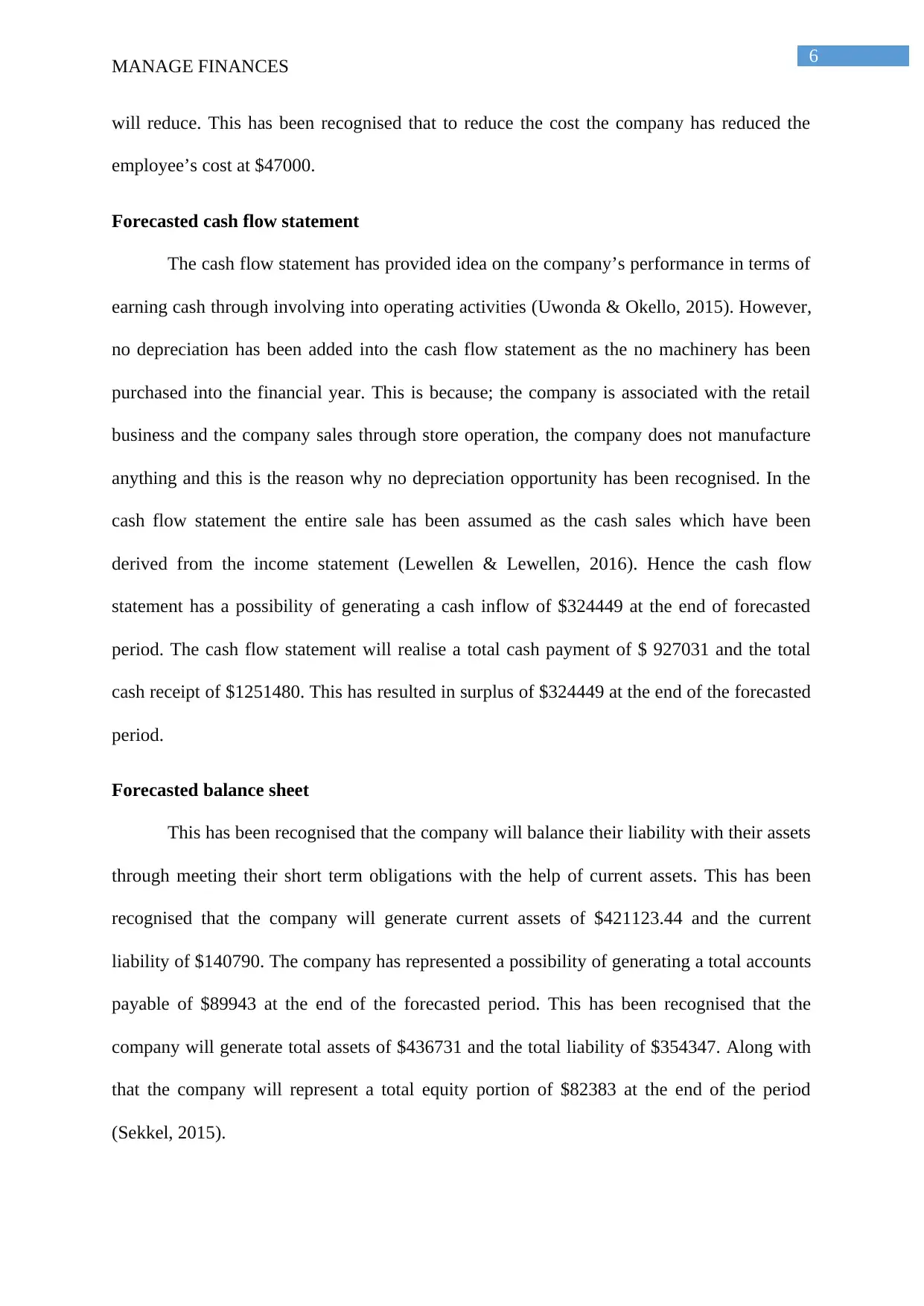
6
MANAGE FINANCES
will reduce. This has been recognised that to reduce the cost the company has reduced the
employee’s cost at $47000.
Forecasted cash flow statement
The cash flow statement has provided idea on the company’s performance in terms of
earning cash through involving into operating activities (Uwonda & Okello, 2015). However,
no depreciation has been added into the cash flow statement as the no machinery has been
purchased into the financial year. This is because; the company is associated with the retail
business and the company sales through store operation, the company does not manufacture
anything and this is the reason why no depreciation opportunity has been recognised. In the
cash flow statement the entire sale has been assumed as the cash sales which have been
derived from the income statement (Lewellen & Lewellen, 2016). Hence the cash flow
statement has a possibility of generating a cash inflow of $324449 at the end of forecasted
period. The cash flow statement will realise a total cash payment of $ 927031 and the total
cash receipt of $1251480. This has resulted in surplus of $324449 at the end of the forecasted
period.
Forecasted balance sheet
This has been recognised that the company will balance their liability with their assets
through meeting their short term obligations with the help of current assets. This has been
recognised that the company will generate current assets of $421123.44 and the current
liability of $140790. The company has represented a possibility of generating a total accounts
payable of $89943 at the end of the forecasted period. This has been recognised that the
company will generate total assets of $436731 and the total liability of $354347. Along with
that the company will represent a total equity portion of $82383 at the end of the period
(Sekkel, 2015).
MANAGE FINANCES
will reduce. This has been recognised that to reduce the cost the company has reduced the
employee’s cost at $47000.
Forecasted cash flow statement
The cash flow statement has provided idea on the company’s performance in terms of
earning cash through involving into operating activities (Uwonda & Okello, 2015). However,
no depreciation has been added into the cash flow statement as the no machinery has been
purchased into the financial year. This is because; the company is associated with the retail
business and the company sales through store operation, the company does not manufacture
anything and this is the reason why no depreciation opportunity has been recognised. In the
cash flow statement the entire sale has been assumed as the cash sales which have been
derived from the income statement (Lewellen & Lewellen, 2016). Hence the cash flow
statement has a possibility of generating a cash inflow of $324449 at the end of forecasted
period. The cash flow statement will realise a total cash payment of $ 927031 and the total
cash receipt of $1251480. This has resulted in surplus of $324449 at the end of the forecasted
period.
Forecasted balance sheet
This has been recognised that the company will balance their liability with their assets
through meeting their short term obligations with the help of current assets. This has been
recognised that the company will generate current assets of $421123.44 and the current
liability of $140790. The company has represented a possibility of generating a total accounts
payable of $89943 at the end of the forecasted period. This has been recognised that the
company will generate total assets of $436731 and the total liability of $354347. Along with
that the company will represent a total equity portion of $82383 at the end of the period
(Sekkel, 2015).
Paraphrase This Document
Need a fresh take? Get an instant paraphrase of this document with our AI Paraphraser
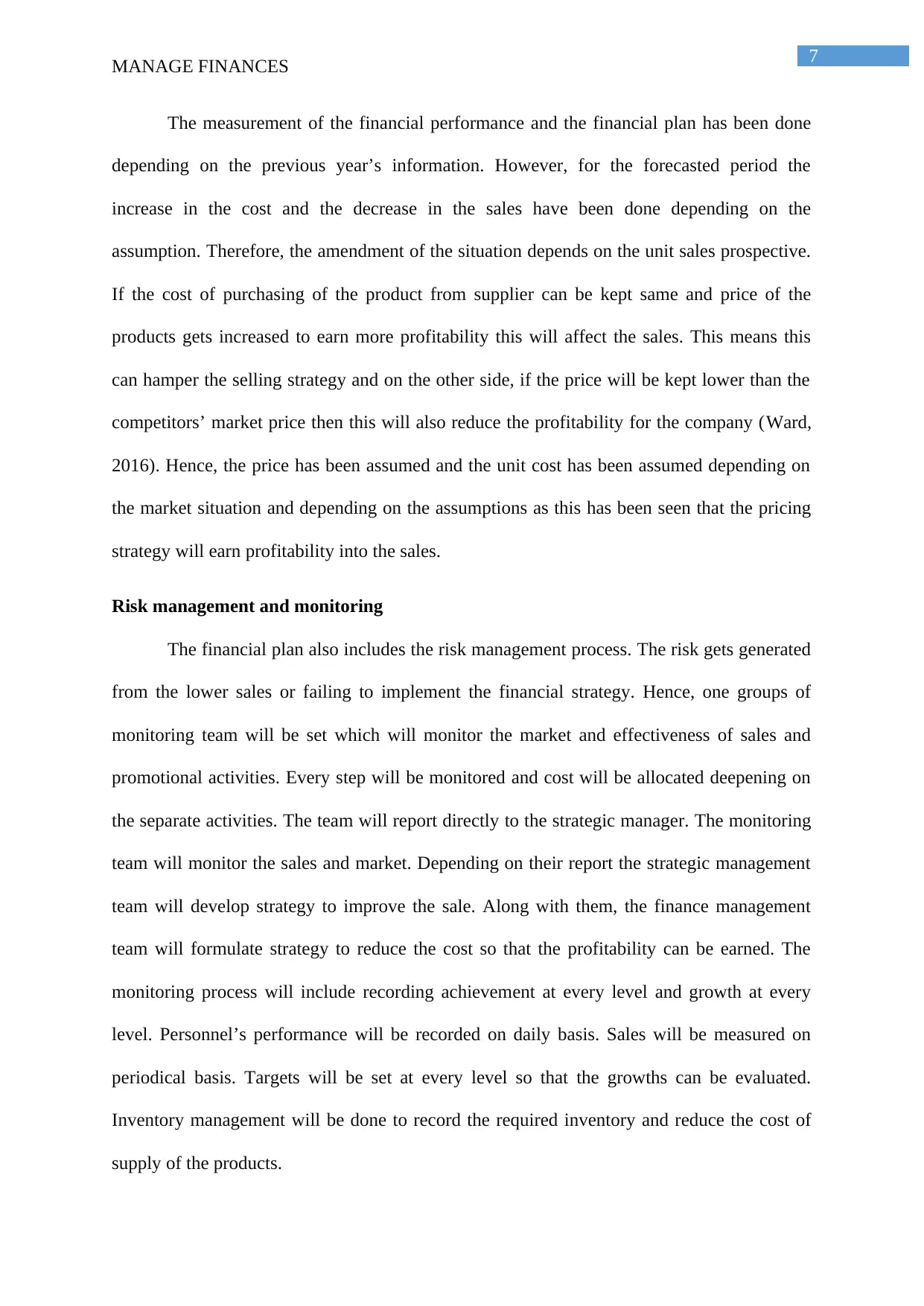
7
MANAGE FINANCES
The measurement of the financial performance and the financial plan has been done
depending on the previous year’s information. However, for the forecasted period the
increase in the cost and the decrease in the sales have been done depending on the
assumption. Therefore, the amendment of the situation depends on the unit sales prospective.
If the cost of purchasing of the product from supplier can be kept same and price of the
products gets increased to earn more profitability this will affect the sales. This means this
can hamper the selling strategy and on the other side, if the price will be kept lower than the
competitors’ market price then this will also reduce the profitability for the company (Ward,
2016). Hence, the price has been assumed and the unit cost has been assumed depending on
the market situation and depending on the assumptions as this has been seen that the pricing
strategy will earn profitability into the sales.
Risk management and monitoring
The financial plan also includes the risk management process. The risk gets generated
from the lower sales or failing to implement the financial strategy. Hence, one groups of
monitoring team will be set which will monitor the market and effectiveness of sales and
promotional activities. Every step will be monitored and cost will be allocated deepening on
the separate activities. The team will report directly to the strategic manager. The monitoring
team will monitor the sales and market. Depending on their report the strategic management
team will develop strategy to improve the sale. Along with them, the finance management
team will formulate strategy to reduce the cost so that the profitability can be earned. The
monitoring process will include recording achievement at every level and growth at every
level. Personnel’s performance will be recorded on daily basis. Sales will be measured on
periodical basis. Targets will be set at every level so that the growths can be evaluated.
Inventory management will be done to record the required inventory and reduce the cost of
supply of the products.
MANAGE FINANCES
The measurement of the financial performance and the financial plan has been done
depending on the previous year’s information. However, for the forecasted period the
increase in the cost and the decrease in the sales have been done depending on the
assumption. Therefore, the amendment of the situation depends on the unit sales prospective.
If the cost of purchasing of the product from supplier can be kept same and price of the
products gets increased to earn more profitability this will affect the sales. This means this
can hamper the selling strategy and on the other side, if the price will be kept lower than the
competitors’ market price then this will also reduce the profitability for the company (Ward,
2016). Hence, the price has been assumed and the unit cost has been assumed depending on
the market situation and depending on the assumptions as this has been seen that the pricing
strategy will earn profitability into the sales.
Risk management and monitoring
The financial plan also includes the risk management process. The risk gets generated
from the lower sales or failing to implement the financial strategy. Hence, one groups of
monitoring team will be set which will monitor the market and effectiveness of sales and
promotional activities. Every step will be monitored and cost will be allocated deepening on
the separate activities. The team will report directly to the strategic manager. The monitoring
team will monitor the sales and market. Depending on their report the strategic management
team will develop strategy to improve the sale. Along with them, the finance management
team will formulate strategy to reduce the cost so that the profitability can be earned. The
monitoring process will include recording achievement at every level and growth at every
level. Personnel’s performance will be recorded on daily basis. Sales will be measured on
periodical basis. Targets will be set at every level so that the growths can be evaluated.
Inventory management will be done to record the required inventory and reduce the cost of
supply of the products.
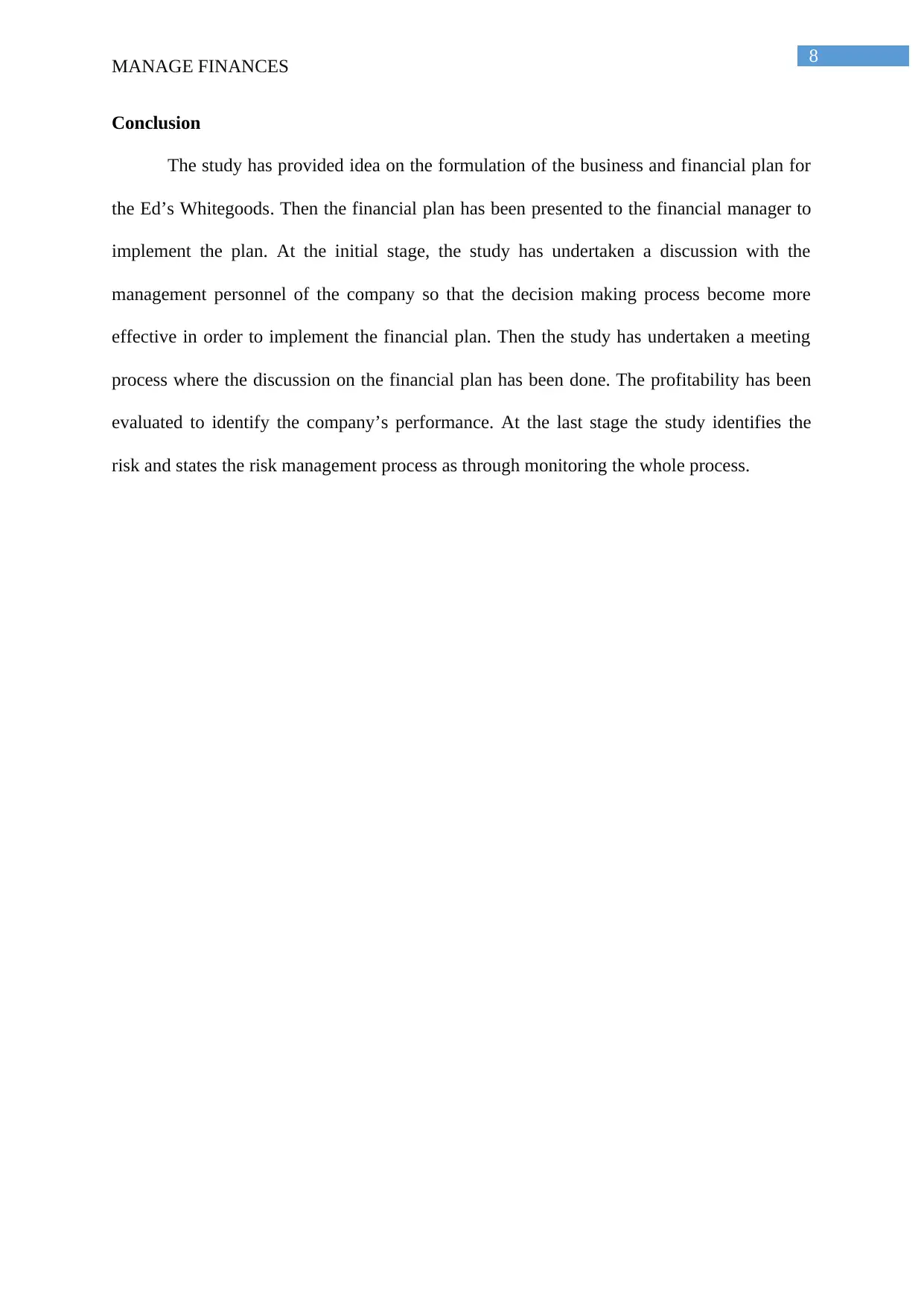
8
MANAGE FINANCES
Conclusion
The study has provided idea on the formulation of the business and financial plan for
the Ed’s Whitegoods. Then the financial plan has been presented to the financial manager to
implement the plan. At the initial stage, the study has undertaken a discussion with the
management personnel of the company so that the decision making process become more
effective in order to implement the financial plan. Then the study has undertaken a meeting
process where the discussion on the financial plan has been done. The profitability has been
evaluated to identify the company’s performance. At the last stage the study identifies the
risk and states the risk management process as through monitoring the whole process.
MANAGE FINANCES
Conclusion
The study has provided idea on the formulation of the business and financial plan for
the Ed’s Whitegoods. Then the financial plan has been presented to the financial manager to
implement the plan. At the initial stage, the study has undertaken a discussion with the
management personnel of the company so that the decision making process become more
effective in order to implement the financial plan. Then the study has undertaken a meeting
process where the discussion on the financial plan has been done. The profitability has been
evaluated to identify the company’s performance. At the last stage the study identifies the
risk and states the risk management process as through monitoring the whole process.
⊘ This is a preview!⊘
Do you want full access?
Subscribe today to unlock all pages.

Trusted by 1+ million students worldwide
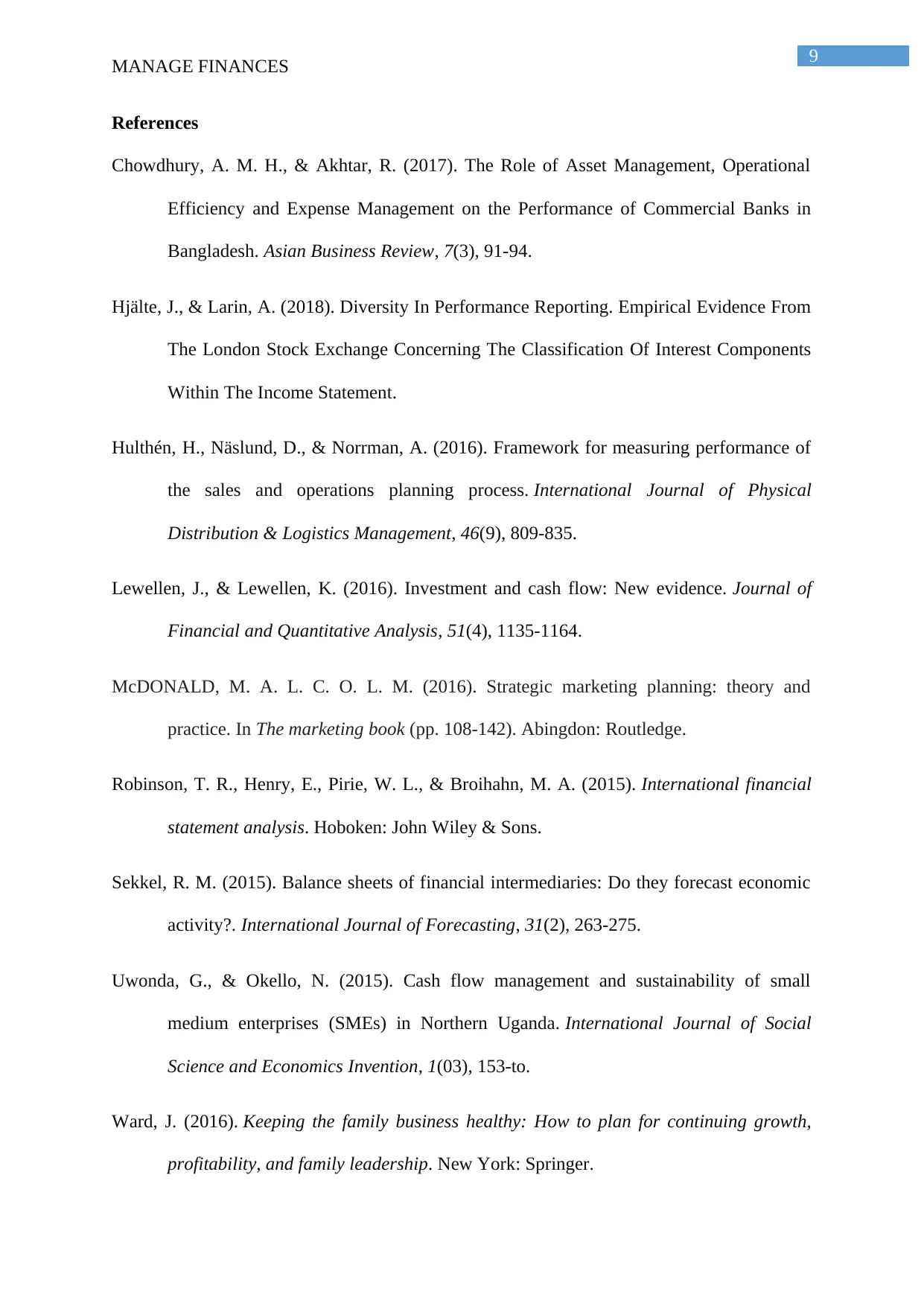
9
MANAGE FINANCES
References
Chowdhury, A. M. H., & Akhtar, R. (2017). The Role of Asset Management, Operational
Efficiency and Expense Management on the Performance of Commercial Banks in
Bangladesh. Asian Business Review, 7(3), 91-94.
Hjälte, J., & Larin, A. (2018). Diversity In Performance Reporting. Empirical Evidence From
The London Stock Exchange Concerning The Classification Of Interest Components
Within The Income Statement.
Hulthén, H., Näslund, D., & Norrman, A. (2016). Framework for measuring performance of
the sales and operations planning process. International Journal of Physical
Distribution & Logistics Management, 46(9), 809-835.
Lewellen, J., & Lewellen, K. (2016). Investment and cash flow: New evidence. Journal of
Financial and Quantitative Analysis, 51(4), 1135-1164.
McDONALD, M. A. L. C. O. L. M. (2016). Strategic marketing planning: theory and
practice. In The marketing book (pp. 108-142). Abingdon: Routledge.
Robinson, T. R., Henry, E., Pirie, W. L., & Broihahn, M. A. (2015). International financial
statement analysis. Hoboken: John Wiley & Sons.
Sekkel, R. M. (2015). Balance sheets of financial intermediaries: Do they forecast economic
activity?. International Journal of Forecasting, 31(2), 263-275.
Uwonda, G., & Okello, N. (2015). Cash flow management and sustainability of small
medium enterprises (SMEs) in Northern Uganda. International Journal of Social
Science and Economics Invention, 1(03), 153-to.
Ward, J. (2016). Keeping the family business healthy: How to plan for continuing growth,
profitability, and family leadership. New York: Springer.
MANAGE FINANCES
References
Chowdhury, A. M. H., & Akhtar, R. (2017). The Role of Asset Management, Operational
Efficiency and Expense Management on the Performance of Commercial Banks in
Bangladesh. Asian Business Review, 7(3), 91-94.
Hjälte, J., & Larin, A. (2018). Diversity In Performance Reporting. Empirical Evidence From
The London Stock Exchange Concerning The Classification Of Interest Components
Within The Income Statement.
Hulthén, H., Näslund, D., & Norrman, A. (2016). Framework for measuring performance of
the sales and operations planning process. International Journal of Physical
Distribution & Logistics Management, 46(9), 809-835.
Lewellen, J., & Lewellen, K. (2016). Investment and cash flow: New evidence. Journal of
Financial and Quantitative Analysis, 51(4), 1135-1164.
McDONALD, M. A. L. C. O. L. M. (2016). Strategic marketing planning: theory and
practice. In The marketing book (pp. 108-142). Abingdon: Routledge.
Robinson, T. R., Henry, E., Pirie, W. L., & Broihahn, M. A. (2015). International financial
statement analysis. Hoboken: John Wiley & Sons.
Sekkel, R. M. (2015). Balance sheets of financial intermediaries: Do they forecast economic
activity?. International Journal of Forecasting, 31(2), 263-275.
Uwonda, G., & Okello, N. (2015). Cash flow management and sustainability of small
medium enterprises (SMEs) in Northern Uganda. International Journal of Social
Science and Economics Invention, 1(03), 153-to.
Ward, J. (2016). Keeping the family business healthy: How to plan for continuing growth,
profitability, and family leadership. New York: Springer.
Paraphrase This Document
Need a fresh take? Get an instant paraphrase of this document with our AI Paraphraser
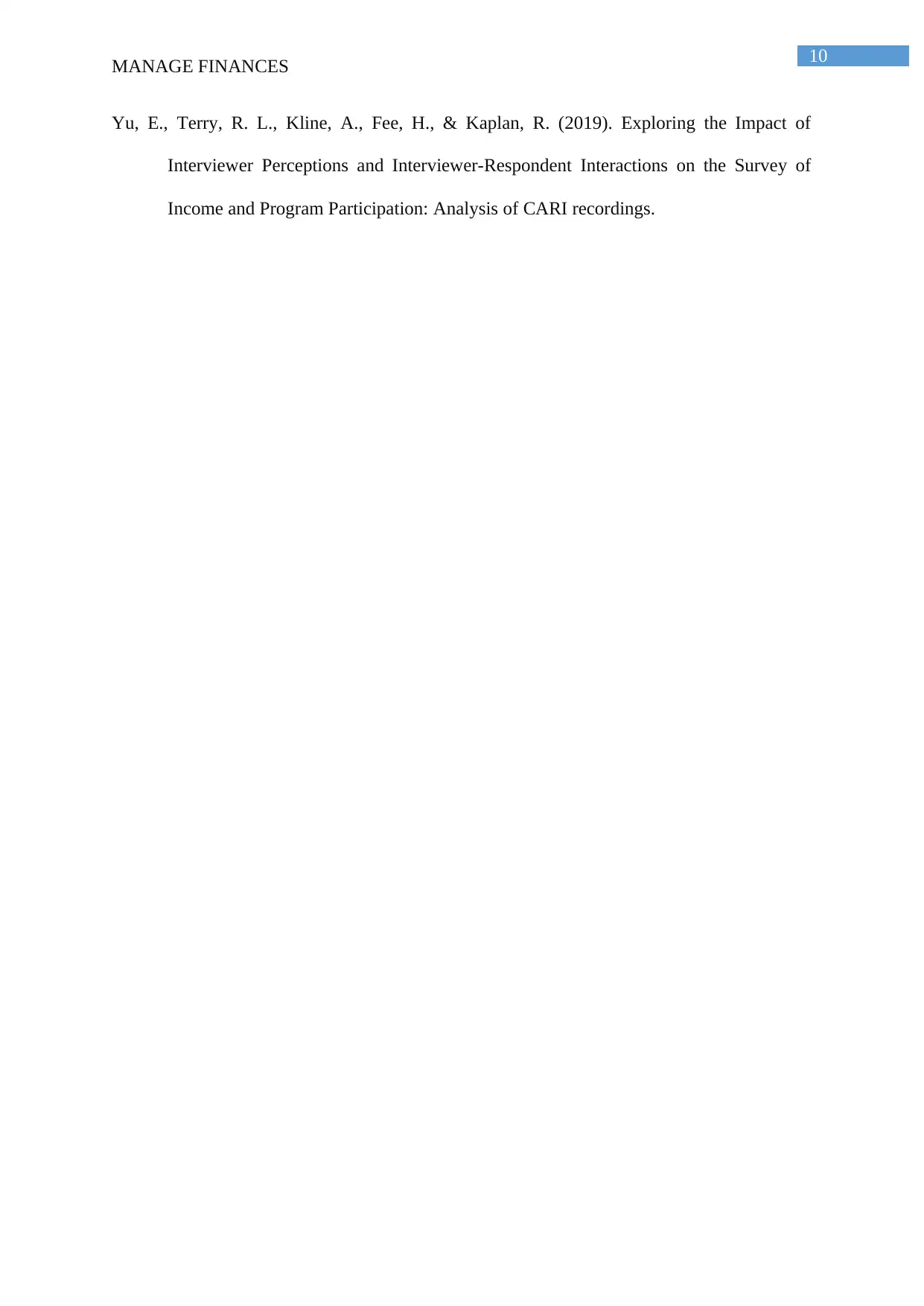
10
MANAGE FINANCES
Yu, E., Terry, R. L., Kline, A., Fee, H., & Kaplan, R. (2019). Exploring the Impact of
Interviewer Perceptions and Interviewer-Respondent Interactions on the Survey of
Income and Program Participation: Analysis of CARI recordings.
MANAGE FINANCES
Yu, E., Terry, R. L., Kline, A., Fee, H., & Kaplan, R. (2019). Exploring the Impact of
Interviewer Perceptions and Interviewer-Respondent Interactions on the Survey of
Income and Program Participation: Analysis of CARI recordings.
1 out of 11
Related Documents
Your All-in-One AI-Powered Toolkit for Academic Success.
+13062052269
info@desklib.com
Available 24*7 on WhatsApp / Email
![[object Object]](/_next/static/media/star-bottom.7253800d.svg)
Unlock your academic potential
Copyright © 2020–2025 A2Z Services. All Rights Reserved. Developed and managed by ZUCOL.





